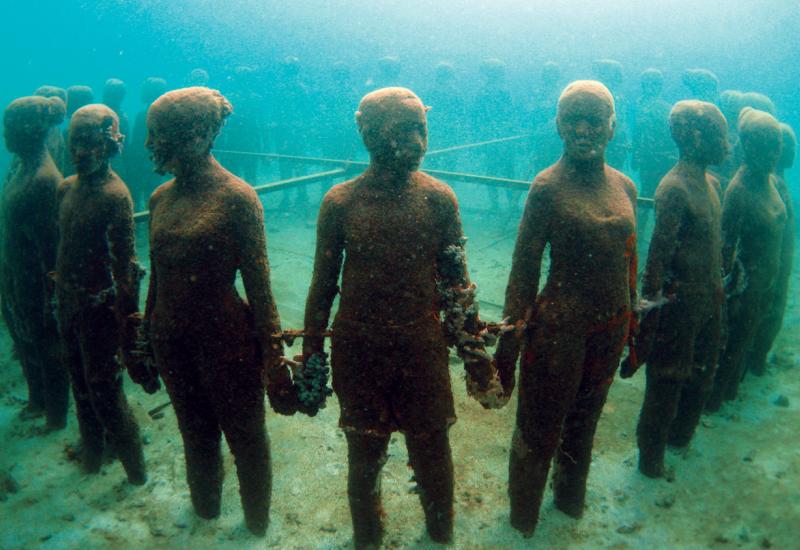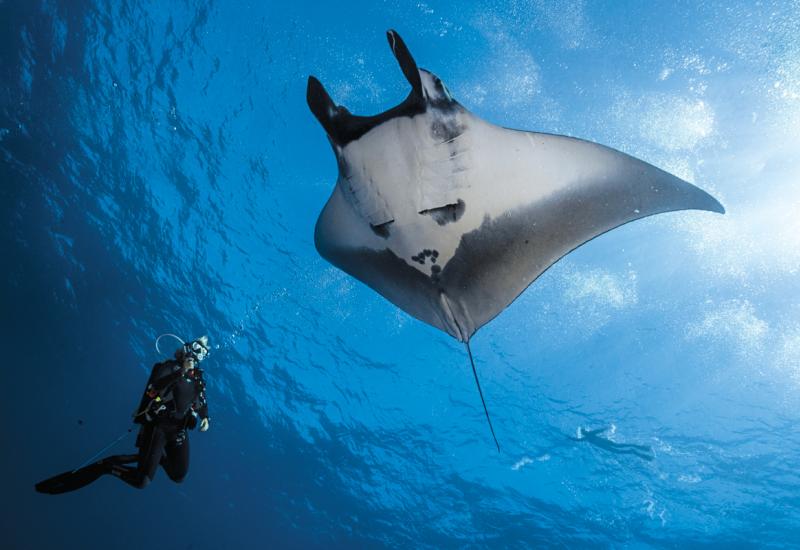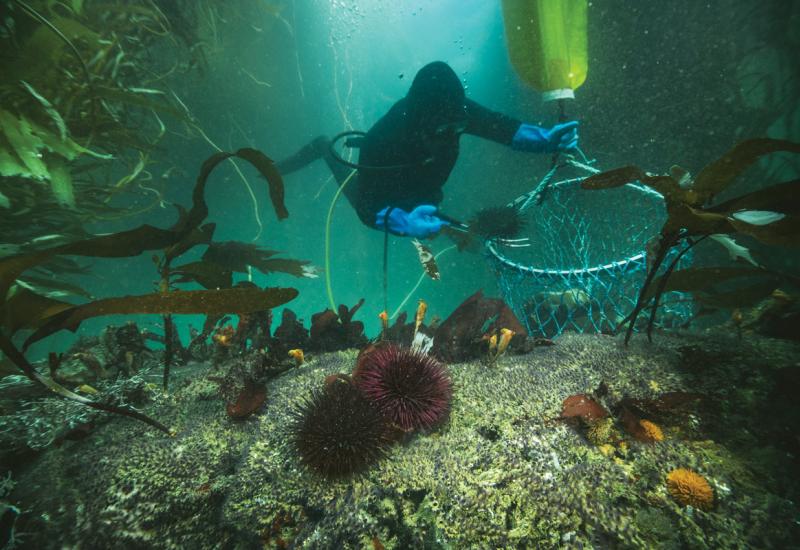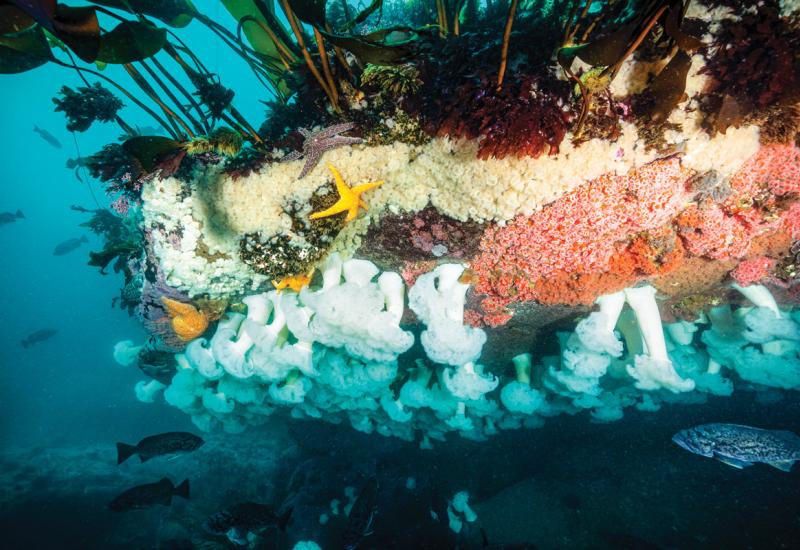NOAA, partners, survey ‘amazingly intact’ historic WWII-era aircraft carrier

The ex-USS Independence at anchor
Aerial view of ex-USS Independence at anchor in San Francisco Bay, California, January 1951. There is visible damage from the atomic bomb tests at Bikini Atoll.
Credit: San Francisco Maritime National Historical Park, P82-019a.3090pl_SAFR 19106
San Francisco Maritime National Historical Park, P82-019a.3090pl_SAFR 19106
April 16, 2015
Contact: Sarah Marquis, 949-222-2212
NOAA, partners, survey ‘amazingly intact’ historic WWII-era aircraft carrier
Former USS Independence served during American naval offensive in Pacific theater
NOAA, working with private industry partners and the U.S. Navy, has confirmed the location and condition of the former USS Independence (CVL 22), the lead ship of its class of light aircraft carriers that were critical during the American naval offensive in the Pacific during World War II.
Resting in 2,600 feet of water off California’s Farallon Islands, the carrier is “amazingly intact,” NOAA scientists said, with its hull and flight deck clearly visible, and what appears to be a plane in the carrier’s hangar bay.
Independence operated in the central and western Pacific from November 1943 through August 1945 and later was one of more than 90 vessels assembled as a target fleet for the Bikini Atoll atomic bomb tests in 1946. Damaged by shock waves, heat and radiation, Independence survived the Bikini Atoll tests and, like dozens of other Operation Crossroads ships, returned to the United States.
While moored at San Francisco’s Hunters Point Naval Shipyard, Independence was the primary focus of the Navy’s studies on decontamination until age and the possibility of its sinking led the Navy to tow the blast-damaged carrier to sea for scuttling on Jan. 26, 1951.
“After 64 years on the seafloor, Independence sits on the bottom as if ready to launch its planes,” said James Delgado, chief scientist on the Independence mission and maritime heritage director for NOAA’s Office of National Marine Sanctuaries. “This ship fought a long, hard war in the Pacific and after the war was subjected to two atomic blasts that ripped through the ship. It is a reminder of the industrial might and skill of the ‘greatest generation’ that sent not only this ship, but their loved ones to war.”
NOAA’s interest in Independence is part of a mandated and ongoing two-year mission to locate, map and study historic shipwrecks in Gulf of the Farallones National Marine Sanctuary and nearby waters. The carrier is one of an estimated 300 wrecks in the waters off San Francisco, and the deepest known shipwreck in the sanctuary.
The mission was conducted last month using an 18.5-foot-long autonomous underwater vehicle (AUV), Echo Ranger, provided by The Boeing Company through a cooperative research and development agreement with NOAA’s Office of Oceanic and Atmospheric Research. Boeing also partnered with technology company Coda Octopus to integrate its 3D-imaging sonar system, Echoscope, into the AUV.
“Boeing is excited for the opportunity to partner with NOAA to utilize this state of the art technology,” said Fred Sheldon, Boeing project manager for AUVs. “The Echo Ranger is uniquely suited for this type of mission and performed perfectly allowing us to conduct a thorough survey of the Independence.”
Scientists and technicians on the sanctuary vessel R/V Fulmar followed the AUV as it glided 150 feet above the wreck and successfully surveyed the carrier’s nearly intact hull. The survey determined that Independence is upright, slightly listing to starboard, with much of its flight deck intact, and with gaping holes leading to the hangar decks that once housed the carrier’s aircraft. To see sonar images, historical photos and other materials, visit http://sanctuaries.noaa.gov/shipwrecks/independence/.
“By using technology to create three-dimensional maps of the seafloor and wrecks like Independence, we can not only explore, but share what we’ve learned with the public and other scientists,” said Frank Cantelas, archaeologist with NOAA’s Office of Ocean Exploration and Research, who joined the mission along with Robert Schwemmer, west coast regional maritime heritage coordinator for NOAA’s Office of National Marine Sanctuaries.
Delgado, primary author of a 1990 scientific report on the history and archaeology of the ships sunk at Bikini Atoll in the Marshall Islands, said currently there are no plans to enter the vessel or survey drums of hazardous and radioactive waste that were dumped in the sanctuary between 1946 and 1970. No trace of the drums or radiation was observed during the mission, Delgado said.
Gulf of the Farallones National Marine Sanctuary encompasses nearly 3,300 square miles of ocean and coastal waters beyond California’s Golden Gate Bridge. The sanctuary supports an abundance of species including the largest breeding seabird rookery in the contiguous United States, and other species such as whales and white sharks.
NOAA’s Office of Ocean Exploration and Research is the only federal agency that advances NOAA and national objectives by systematically exploring the planet’s largely unknown ocean for the purpose of discovery and the advancement of knowledge.
NOAA’s mission is to understand and predict changes in the Earth's environment, from the depths of the ocean to the surface of the sun, and to conserve and manage our coastal and marine resources. Join us on Twitter, Facebook, Instagram and our other social media channels.
--------------------
Vernon Smith
National Media Coordinator
NOAA Office of National Marine Sanctuaries
301-713-7248 (Desk)
240-638-6447 (Cell)
[email protected]
http://sanctuaries.noaa.gov
--
Download the NOAA fact sheet PDF and check out the video from Boeing below.

San Francisco Maritime National Historical Park, P82-019a.3090pl_SAFR 19106Aerial view of ex-USS Independence at anchor in San Francisco Bay, California, January 1951. There is visible damage from the atomic bomb tests at Bikini Atoll.
April 16, 2015
Contact: Sarah Marquis, 949-222-2212
NOAA, partners, survey ‘amazingly intact’ historic WWII-era aircraft carrier Former USS Independence served during American naval offensive in Pacific theater
NOAA, working with private industry partners and the U.S. Navy, has confirmed the location and condition of the former USS Independence (CVL 22), the lead ship of its class of light aircraft carriers that were critical during the American naval offensive in the Pacific during World War II.
Resting in 2,600 feet of water off California’s Farallon Islands, the carrier is “amazingly intact,” NOAA scientists said, with its hull and flight deck clearly visible, and what appears to be a plane in the carrier’s hangar bay.
Independence operated in the central and western Pacific from November 1943 through August 1945 and later was one of more than 90 vessels assembled as a target fleet for the Bikini Atoll atomic bomb tests in 1946. Damaged by shock waves, heat and radiation, Independence survived the Bikini Atoll tests and, like dozens of other Operation Crossroads ships, returned to the United States.
While moored at San Francisco’s Hunters Point Naval Shipyard, Independence was the primary focus of the Navy’s studies on decontamination until age and the possibility of its sinking led the Navy to tow the blast-damaged carrier to sea for scuttling on Jan. 26, 1951.
“After 64 years on the seafloor, Independence sits on the bottom as if ready to launch its planes,” said James Delgado, chief scientist on the Independence mission and maritime heritage director for NOAA’s Office of National Marine Sanctuaries. “This ship fought a long, hard war in the Pacific and after the war was subjected to two atomic blasts that ripped through the ship. It is a reminder of the industrial might and skill of the ‘greatest generation’ that sent not only this ship, but their loved ones to war.”
NOAA’s interest in Independence is part of a mandated and ongoing two-year mission to locate, map and study historic shipwrecks in Gulf of the Farallones National Marine Sanctuary and nearby waters. The carrier is one of an estimated 300 wrecks in the waters off San Francisco, and the deepest known shipwreck in the sanctuary.
The mission was conducted last month using an 18.5-foot-long autonomous underwater vehicle (AUV), Echo Ranger, provided by The Boeing Company through a cooperative research and development agreement with NOAA’s Office of Oceanic and Atmospheric Research. Boeing also partnered with technology company Coda Octopus to integrate its 3D-imaging sonar system, Echoscope, into the AUV.
“Boeing is excited for the opportunity to partner with NOAA to utilize this state of the art technology,” said Fred Sheldon, Boeing project manager for AUVs. “The Echo Ranger is uniquely suited for this type of mission and performed perfectly allowing us to conduct a thorough survey of the Independence.”
Scientists and technicians on the sanctuary vessel R/V Fulmar followed the AUV as it glided 150 feet above the wreck and successfully surveyed the carrier’s nearly intact hull. The survey determined that Independence is upright, slightly listing to starboard, with much of its flight deck intact, and with gaping holes leading to the hangar decks that once housed the carrier’s aircraft. To see sonar images, historical photos and other materials, visit http://sanctuaries.noaa.gov/shipwrecks/independence/.
“By using technology to create three-dimensional maps of the seafloor and wrecks like Independence, we can not only explore, but share what we’ve learned with the public and other scientists,” said Frank Cantelas, archaeologist with NOAA’s Office of Ocean Exploration and Research, who joined the mission along with Robert Schwemmer, west coast regional maritime heritage coordinator for NOAA’s Office of National Marine Sanctuaries.
Delgado, primary author of a 1990 scientific report on the history and archaeology of the ships sunk at Bikini Atoll in the Marshall Islands, said currently there are no plans to enter the vessel or survey drums of hazardous and radioactive waste that were dumped in the sanctuary between 1946 and 1970. No trace of the drums or radiation was observed during the mission, Delgado said.
Gulf of the Farallones National Marine Sanctuary encompasses nearly 3,300 square miles of ocean and coastal waters beyond California’s Golden Gate Bridge. The sanctuary supports an abundance of species including the largest breeding seabird rookery in the contiguous United States, and other species such as whales and white sharks.
NOAA’s Office of Ocean Exploration and Research is the only federal agency that advances NOAA and national objectives by systematically exploring the planet’s largely unknown ocean for the purpose of discovery and the advancement of knowledge.
NOAA’s mission is to understand and predict changes in the Earth's environment, from the depths of the ocean to the surface of the sun, and to conserve and manage our coastal and marine resources. Join us on Twitter, Facebook, Instagram and our other social media channels.
--------------------
Vernon Smith
National Media Coordinator
NOAA Office of National Marine Sanctuaries
301-713-7248 (Desk)
240-638-6447 (Cell)
[email protected]
http://sanctuaries.noaa.gov
--
Download the NOAA fact sheet PDF and check out the video from Boeing below.

NOAA, Boeing, and Coda Octopus
Features on an historic photo of USS Independence CVL 22 are captured in a three-dimensional (3D) low-resolution sonar image of the shipwreck in Monterey Bay National Marine Sanctuary. The Coda Octopus Echoscope 3D sonar, integrated on the Boeing Autonomous Underwater Vehicle (AUV) Echo Ranger, imaged the shipwreck during the first maritime archaeological survey. The sonar image with oranges color tones (lower) shows an outline of a possible airplane in the forward aircraft elevator hatch opening.

NOAA's Office of Ocean Exploration and Research and NOAA's Office of National Marine Sanctuaries
The shipwreck site of the former aircraft carrier, Independence, is located in the northern region of Monterey Bay National Marine Sanctuary. Half Moon Bay, California was the port of operations for the Independence survey mission. The first multibeam sonar survey of the Independence site was conducted by the NOAA ship Okeanos Explorer in 2009.

U.S. Navy, National Archives, 80-74436Aerial view of USS Independence (CVL 22) underway July 15, 1943 in San Francisco Bay, California. Before departing San Francisco, USS Independence’s hull classification changed from CV 22 “aircraft carrier” to CVL 22, “light aircraft carrier.”

U.S. Navy, National ArchivesMuster on the flight deck of USS Independence (CVL 22), 1943. “Attention to Colors,” as the American flag is being hoisted aloft.

BoeingIllustration of Echo Ranger

Robert V. Schwemmer, NOAA
Boeing's project engineer, Ross Peterson, oversees the installation of the lithium polymer battery into Boeing's Autonomous Underwater Vehicle (AUV) Echo Ranger at Half Moon Bay. The battery is specifically designed for the AUV, providing the power needed for the 60 mile roundtrip mission in the Monterey Bay National Marine Sanctuary.

Robert V. Schwemmer, NOAA
During the 2015 mission to survey the ex-USS Independence CVL 22, the Office of National Marine Sanctuaries' research vessel Fulmar served as the escort boat for Boeing’s Autonomous Underwater Vehicle (AUV) Echo Ranger. The 67-foot aluminum catamaran research vessel’s crew is preparing to tow Echo Ranger to sea.

San Francisco Maritime National Historical Park, P82-019a.3090pl_SAFR 19106Aerial view of ex-USS Independence at anchor in San Francisco Bay, California, January 1951. There is visible damage from the atomic bomb tests at Bikini Atoll.










